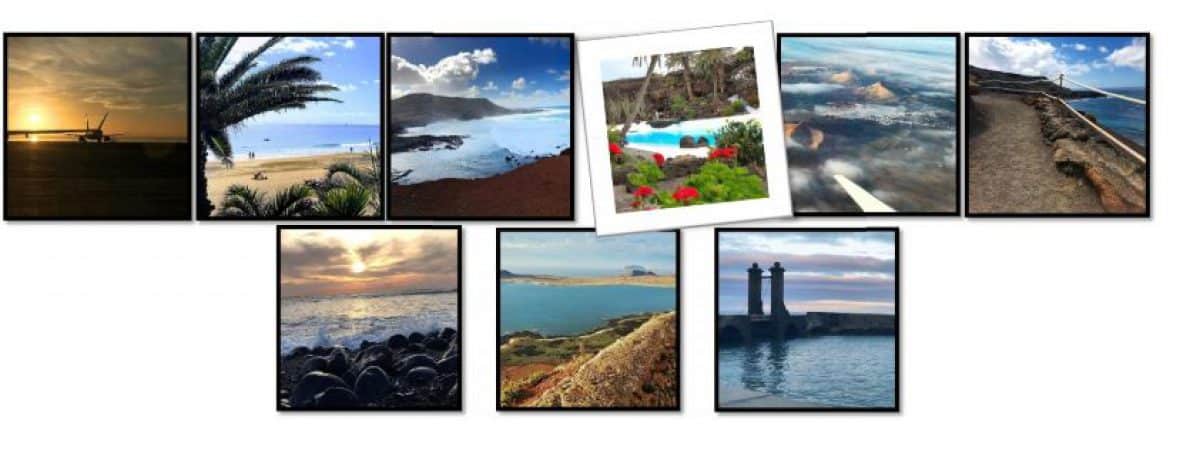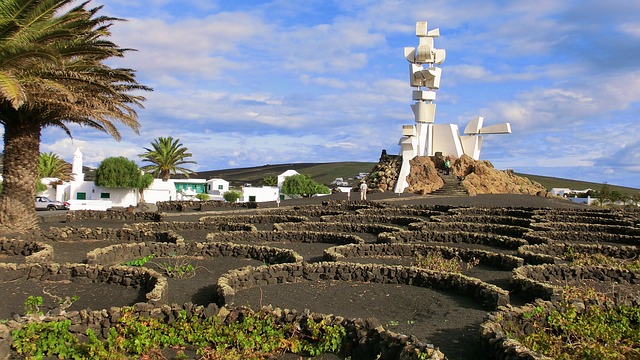This post is also available in:  Español (Spanish)
Español (Spanish)
The Monument to the Farmer Lanzarote, created by César Manrique, is a symbol that pays tribute to the workers of the field. Today, we analyse its history, meaning, and cultural significance of this famous monument.
History and Meaning of the Monument to the Farmer
Origins and Objectives of the Monument
Created in 1968 and located in the heart of Lanzarote, the Monument to the Farmer is a tribute to the dedication of the island’s farmers. Also called the Monument to Fertility, it represents the union between humans and the land, symbolising the hard work and effort of farmers in cultivating seemingly arid and volcanic terrain.
This monument also serves as a reminder of the importance of agriculture in the island’s identity.
César Manrique: The Artist Behind the Tribute
Lanzarote artist César Manrique merged art and nature in his works of painting, sculpture, architecture, and landscaping. After studying in Madrid and New York, he returned to his native island in the 1960s to preserve its natural beauty, advocating for sustainable development and opposing mass tourism. The Monument to the Farmer Lanzarote is an example of his dedication to the local culture and landscape.
Cultural Importance for Lanzarote
Beyond being a creation by César Manrique, the monument symbolises respect for agricultural labour, which has been fundamental to the island’s history. Its form represents the struggle against challenges, creativity in cultivating volcanic soils, and the connection between humans and their environment.
Description of the Monument
The Fertility Sculpture
The Monument to the Farmer Lanzarote is an eye-catching 15-meter sculpture that blends into the volcanic landscape, where the white of the sculpture contrasts with the black soil. Surrounding it is a small garden with typical island plants and crops, such as fig trees, prickly pears, and vines.
Innovative Materials and Design
This artwork, constructed with iron and concrete, stands out atop a pile of volcanic rocks. Its design combines modernity with tradition, using old ship tanks as the base for the sculpture. Manrique created a piece that has become one of Lanzarote’s most iconic landmarks.
Location and Accessibility
It is situated in central Lanzarote, in the municipality of San Bartolomé. This location makes it an ideal spot for visitors. The monument, located next to the House of the Farmer, is part of an architectural complex and is easily accessible, with clear signage from the main roads.
The Visitor Experience
What to Expect at the Farmer’s Museum
Visiting the Farmer’s Museum is like taking a journey through time and exploring Lanzarote’s history. Here, you can see ancient farming tools, typical architecture, and the island’s craftsmanship. There are also interactive exhibits that help visitors understand how crops are cultivated and how they have adapted to the volcanic environment.
Activities and Exhibitions
In addition to enjoying traditional architecture and farming tools, there are museums and galleries offering a range of activities. From craft workshops where you can learn to weave or create local products to demonstrations of ancient farming techniques.
There are also permanent and temporary exhibitions with informative panels and traditional objects. A special area displays an original home, showcasing how farmers lived and what tools they used in their daily tasks.
Restaurant and Local Gastronomy
After touring the museum and learning about Lanzarote’s farming history, you can enjoy the cuisine at the Farmer’s Museum restaurant. This restaurant, located in a volcanic cave, offers a menu featuring local ingredients and traditional recipes, such as wrinkled potatoes with mojo sauce, Canarian stew, or Majorero cheese, paired with local wines.

Social and Economic Impact
Recognition of Lanzarote’s Farmers
The Farmer’s Museum, along with its famous sculpture, has been crucial in valuing agriculture and farmers in Lanzarote. Its exhibitions and events highlight the ingenuity and resilience of farmers who have transformed arid volcanic soil into fertile land. Additionally, this site has boosted the local economy by attracting rural and sustainable tourism to the island.
Tourism and Cultural Education
The tourist complex has generated employment and expanded the region’s tourist offerings. The monument has been instrumental in cultural education, teaching young people about the farmers’ legacy and promoting respect for Lanzarote’s natural and cultural heritage.
How to Visit the Monument
Opening Hours and Entry Prices
You can visit the House-Museum and the monument for free, open daily from 10:00 AM to 6:00 PM. You are free to explore the facilities, although guided tours are available for a deeper experience. There are various tours in Lanzarote that you can consult.
Tips for Visiting
To make the most of your visit, wear comfortable shoes, as you’ll be walking in open-air spaces. It’s also important to bring a hat and good sunscreen, especially during the hotter months.
As mentioned, taking a guided tour to learn and fully experience the region’s iconic spots is a great option. Don’t forget to try the local cuisine.
Special Events and Seasons
The Monument to the Farmer is perfect for immersing yourself in Lanzarote’s culture, as it hosts a varied program throughout the year. The patron saint festivities of San Bartolomé are a great opportunity to enjoy concerts, exhibitions, and sample local products. We recommend checking its official website to plan your visit.
Conclusion: A Living Legacy
Reflections on the Monument
This work not only adorns the volcanic landscape, but also reminds us of the importance of preserving our cultural and natural heritage. By visiting the monument, tourists can reflect on human resilience and the beauty of adapting to the environment.
The Future of the Monument to the Farmer
The Monument to the Farmer Lanzarote has a promising future for generations to come. Its ability to unite the past and present makes it a benchmark for cultural and sustainable tourism. It will likely remain an active site for events and activities that promote creativity, education, and connection with nature.
This post is also available in:  Español (Spanish)
Español (Spanish)

